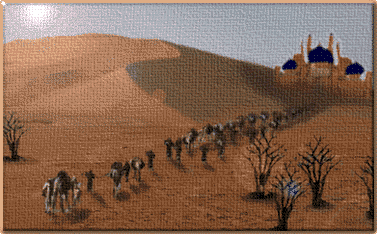Pictures taken from the space shuttle find lost city of Ubar

Feb. 5, 1992...The lost city of Ubar, called "the Atlantis of the Sands" by Lawrence of Arabia, has been found in remote southern Oman using pictures taken from space shuttle Challenger, explorers said Tuesday.
The researchers speculate that the city may have been the earliest known shipping center for frankincense, a fragrant gum resin harvested farther south. The researchers have to overcome sandstorms and deadly vipers to locate the city's octagon-shaped stone walls, 6- to 8-foot-tall remnants of seven of its eight 30-foot-tall mud-brick towers, various rooms, frankincense burners and thousands of pieces of pottery.
Researchers found the city by tracing ancient desert roads detected in pictures taken from several spacecraft, including radar and optical cameras carried by Challenger in October 1984, said Ronald Blom, a geologist at NASA's Jet Propulsion Laboratory in Pasadena. Evidence indicates that the city fell into a sinkhole created when an underground limestone cavern collapsed. According to legend, Ubar was destroyed during a disaster about C.E. 100 and was buried by sand. The city probably had fewer than 100 residents, but was surrounded by numerous campsites marked by pottery, firepits and charcoal.
Previous efforts to find Ubar in Oman's dunes failed in 1930, 1947 and 1953.
The lost city's relationship with the nation of 'Ad as mentioned in the Holy Quran is unclear.
Below is just one reference to the people of 'Ad in the Holy Quran.
In the name of God, Most Gracious, Most Merciful.
By the Break of Day; By the Nights twice five; By the Even and Odd (contrasted); And by the Night when it passeth away; Is there (not) in these an adjuration (or evidence) for those who understand? Seest thou not how thy Lord dealt with the `Ad (people); Of the (city of) Iram, with lofty pillars; The like of which were not produced in (all) the land? And with the Thamud (people), who cut out (huge) rocks in the valley? And with Pharaoh, Lord of Stakes? (All) these transgressed Beyond bounds in the lands. And heaped therein Mischief (on mischief). Therefore did thy Lord pour on them a scourge of diverse chastisement: For thy Lord is (As a Guardian) on a watch-tower. (Holy Quran,Surah Al-Fajr, The Dawn,89:1-89:14)
The ancient 'Ad are called 'Ad Iram for the reason that they belonged to that branch of the Semitic race which descended from Iram, son of Shem, son of Noah (peace be on him).
If the above city was destroyed around 100 C.E., then it can not be the city of ancient 'Ad, to whom Prophet Hud (p.b.u.h.) was sent.
Acknowledgment: The picture is taken from NASA's page. Read the full story at http://observe.ivv.nasa.gov/nasa/exhibits/ubar/ubar_0.html
compiled by Ishaq Zahid
